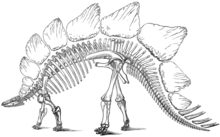Stegosaurus
Stegosaurus (/ˌstɛɡəˈsɔːrəs/;[1] lit. 'roof-lizard') is a genus of herbivorous, four-legged, armored dinosaur from the Late Jurassic, characterized by the distinctive kite-shaped upright plates along their backs and spikes on their tails. Fossils of this dinosaur have been found in the western United States and in Portugal, where they are found in Kimmeridgian- to early Tithonian-aged strata, dating to between 155 and 145 million years ago. Of the species that have been classified in the upper Morrison Formation of the western US, only three are universally recognized: S. stenops, S. ungulatus and S. sulcatus. The remains of over 80 individual animals of this genus have been found. Stegosaurus would have lived alongside dinosaurs such as Apatosaurus, Diplodocus, Brachiosaurus, Allosaurus, and Ceratosaurus; the latter two may have preyed on it.
These were large, heavily built, herbivorous quadrupeds with rounded backs, short fore limbs, long hind limbs, and tails held high in the air. Due to their distinctive combination of broad, upright plates and tail tipped with spikes, Stegosaurus is one of the most recognizable kinds of dinosaurs. The function of this array of plates and spikes has been the subject of much speculation among scientists. Today, it is generally agreed that their spiked tails were most likely used for defense against predators, while their plates may have been used primarily for display, and secondarily for thermoregulatory functions. Stegosaurus had a relatively low brain-to-body mass ratio. It had a short neck and a small head, meaning it most likely ate low-lying bushes and shrubs. One species, Stegosaurus ungulatus, is the largest known of all the stegosaurians (bigger than related dinosaurs such as Kentrosaurus and Huayangosaurus).
Stegosaurus remains were first identified during the "Bone Wars" by Othniel Charles Marsh at Dinosaur Ridge National Landmark. The first known skeletons were fragmentary and the bones were scattered, and it would be many years before the true appearance of these animals, including their posture and plate arrangement, became well understood. Despite its popularity in books and film, mounted skeletons of Stegosaurus did not become a staple of major natural history museums until the mid-20th century, and many museums have had to assemble composite displays from several different specimens due to a lack of complete skeletons. Stegosaurusis one of the better-known dinosaurs, and has been featured in film, postal stamps, and many other types of media.
Stegosaurus, one of the many dinosaurs first collected and described in the Bone Wars, was originally named by Othniel Charles Marsh in 1877,[2] from remains recovered north of Morrison, Colorado. These first bones became the holotype of Stegosaurus armatus. Marsh initially believed the remains were from an aquatic turtle-like animal, and the basis for its scientific name, 'roof(ed) lizard' was due to his early belief that the plates lay flat over the animal's back, overlapping like the shingles (tiles) on a roof. A wealth of Stegosaurus material was recovered over the next few years, and Marsh published several papers on the genus from 1877 to 1897.[3] In 1878, Edward Drinker Cope named Hypsirhophus discurus as another stegosaurian based on fragmentary fossils from Cope's Quarry 3 near the "Cope's Nipple" site in Garden Park, Colorado.[4] Many later researchers have considered Hypsirhophus to be a synonym of Stegosaurus,[3] though Peter Galton (2010) suggested that it is distinct based on differences in the vertebrae.[5]

